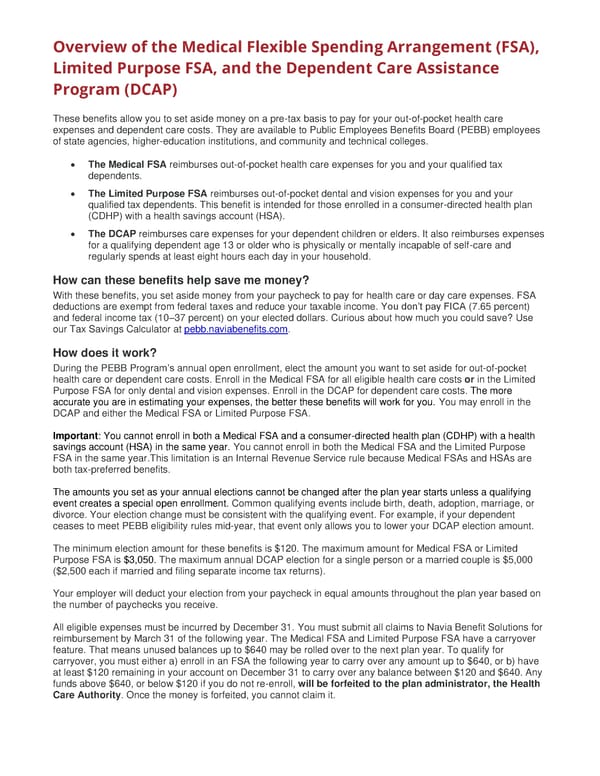FSA overview
Overview of the Medical Flexible Spending Arrangement (FSA), Limited Purpose FSA, and the Dependent Care Assistance Program (DCAP) These benefits allow you to set aside money on a pre-tax basis to pay for your out-of-pocket health care expenses and dependent care costs. They are available to Public Employees Benefits Board (PEBB) employees of state agencies, higher-education institutions, and community and technical colleges. • The Medical FSA reimburses out-of-pocket health care expenses for you and your qualified tax dependents. • The Limited Purpose FSA reimburses out-of-pocket dental and vision expenses for you and your qualified tax dependents. This benefit is intended for those enrolled in a consumer-directed health plan (CDHP) with a health savings account (HSA). • The DCAP reimburses care expenses for your dependent children or elders. It also reimburses expenses for a qualifying dependent age 13 or older who is physically or mentally incapable of self-care and regularly spends at least eight hours each day in your household. How can these benefits help save me money? With these benefits, you set aside money from your paycheck to pay for health care or day care expenses. FSA deductions are exempt from federal taxes and reduce your taxable income. You don’t pay FICA (7.65 percent) and federal income tax (10–37 percent) on your elected dollars. Curious about how much you could save? Use our Tax Savings Calculator at pebb.naviabenefits.com. How does it work? During the PEBB Program’s annual open enrollment, elect the amount you want to set aside for out-of-pocket health care or dependent care costs. Enroll in the Medical FSA for all eligible health care costs or in the Limited Purpose FSA for only dental and vision expenses. Enroll in the DCAP for dependent care costs. The more accurate you are in estimating your expenses, the better these benefits will work for you. You may enroll in the DCAP and either the Medical FSA or Limited Purpose FSA. Important: You cannot enroll in both a Medical FSA and a consumer-directed health plan (CDHP) with a health savings account (HSA) in the same year. You cannot enroll in both the Medical FSA and the Limited Purpose FSA in the same year.This limitation is an Internal Revenue Service rule because Medical FSAs and HSAs are both tax-preferred benefits. The amounts you set as your annual elections cannot be changed after the plan year starts unless a qualifying event creates a special open enrollment. Common qualifying events include birth, death, adoption, marriage, or divorce. Your election change must be consistent with the qualifying event. For example, if your dependent ceases to meet PEBB eligibility rules mid-year, that event only allows you to lower your DCAP election amount. The minimum election amount for these benefits is $120. The maximum amount for Medical FSA or Limited Purpose FSA is $3,050. The maximum annual DCAP election for a single person or a married couple is $5,000 ($2,500 each if married and filing separate income tax returns). Your employer will deduct your election from your paycheck in equal amounts throughout the plan year based on the number of paychecks you receive. All eligible expenses must be incurred by December 31. You must submit all claims to Navia Benefit Solutions for reimbursement by March 31 of the following year. The Medical FSA and Limited Purpose FSA have a carryover feature. That means unused balances up to $640 may be rolled over to the next plan year. To qualify for carryover, you must either a) enroll in an FSA the following year to carry over any amount up to $640, or b) have at least $120 remaining in your account on December 31 to carry over any balance between $120 and $640. Any funds above $640, or below $120 if you do not re-enroll, will be forfeited to the plan administrator, the Health Care Authority. Once the money is forfeited, you cannot claim it.
 FSA overview Page 2
FSA overview Page 2